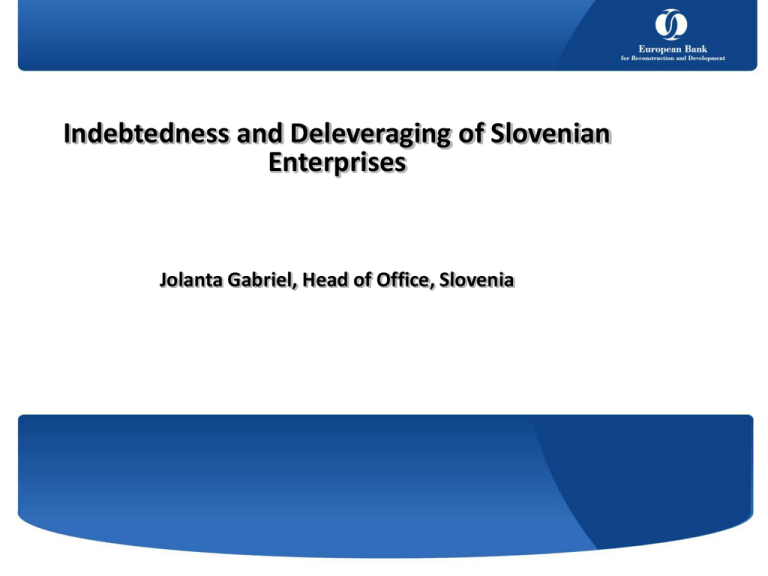
Indebtedness and Deleveraging of Slovenian
Enterprises
Jolanta Gabriel, Head of Office, Slovenia
Agenda:
•Extent of corporate indebtedness
•How to address the corporate indebtedness
•EBRD’s role in restructuring and deleveraging
September 2013
© EBRD 2014, all rights reserved
Corporate debt overhang
Debt piling up after 2004 – reasons:
-
Access to cheap bank credit, mainly short term bilateral, collateral based
(rather than cash-flow based)
-
Too aggressive investment in non-core assets, expansion without proper cost
return analysis;
-
Management buy-outs with no cash equity at risk, financed by bank debt
-
Weak financial management, reporting, ownership control
-
Weak early warning systems within banking
3
Lessons Learnt from the Region
•Restructuring projects face several obstacles:
•Inappropriate recognition of the situation – hence delayed reaction by the
management, shareholders and lenders;
•Lack of precedents – lenders are not experienced; many jurisdictions favour
equity holders and require new bankruptcy legislation;
•Poor financial management within companies in restructuring and lack of local
restructuring expertise;
•Most companies face tight liquidity with a large volume of unpaid payables,
leading to pressure also from suppliers which normally escalates the situation fast.
4
Net debt and number of firms
(2010-2012; bn. €)
25,500
80.0%
70.7%
25,000
• Net debt =
Debt – (cash + liq.ass.)
69.2%
69.8%
70.0%
24,500
60.0%
50.0%
23,500
23,000
23,195
22,500
40.0%
30.0%
22,453
22,000
22,117
20.0%
21,500
10.0%
21,000
25,079
25,012
24,667
2010
2011
2012
20,500
0.0%
Net debt
•Net debt ≈ 70% of GDP
•Increasing number of firms with net debt
No. Firms
Net debt/GDP
net debt/GDP (%)
net debt (bn eur)
24,000
Magnitude of financial leverage
(2012)
8,000
14,000
25 % firms
46 % debt
Net debt
No. Firms
7,000
12,000
6,129
50 % firms
21 % debt
6,000
number of firms
10,000
4,459
8,000
4,000
3,080
11,400
6,000
3,000
2,280
2,079
1,995
3,140
3,210
5-7
7 - 10
4,000
1,726
2,000
1,447
1,000
542
1,460
1,520
1,620
1,770
1-2
2-3
3-4
4-5
2,000
0
0
0-1
net debt/EBITDA ra o
•Leverage = Net debt / EBITDA
> 10
net debt (mn. eur)
5,000
25 % firms
33 % debt
Excessive debt highly concentrated
(2012; bn. €)
top 300
70%
top 100
56%
top 50
49%
top 30
44%
(Ra ng B)
(Ra ng Ba)
(r=4)
top 10
35%
0%
•
10%
20%
30%
40%
50%
60%
70%
80%
1/3 of exc. debt held by Top 10 debtor firms; 1/2 of exc. debt held by Top 50
debtor firms ; 70 % of exc. debt held by Top 300 debtor firms
Key: Financial soundness is essential for day-to-day
operations and growth
Firms facing excessive debt experience liquidity
problems - normal operations become more difficult
(WC, and essential capex)
Excessive debt becomes self-perpetuating
• firms are unable to deleverage due to falling revenues in the
wake of recession,
• while recessions is protracted due to debt overhang
• Solutions are needed
8
Steps to support restructuring
Legal framework improved:
•
Adoption of amendments to the Insolvency Law in November 2013
•
Adoption of Slovenian Principles of Debt Restructuring in March 2014
– key step in strengthening out-of-court restructurings in support of
viable enterprises.
Creation of BAMC and NPL transfer of NLB and NKBM in
January 2014:
•
BAMC focus on restructuring of viable companies with sound
underlying core business – operational and financial – process
continue to be coordinated with debt holders and shareholders
Privatisation process – good start with 15 companies, but
more comprehensive strategy for state assets is needed
soon (SDH)
9
Steps to support restructuring
• Banks – more coordinated approach
‒
‒
‒
‒
Fair burden sharing between banks and shareholders through D-E swaps & debt
write off or rescheduling
Insisting on strengthening management (role of CRO) and corporate governance
Restructuring debt with better security sharing arrangements, alignment of
terms and covenants;
Strengthening monitoring of implementation of restructuring
• Provision of new debt or terms to allow new
necessary liquidity for WC and investment needs to
be unlocked
• Further sale of NPL portfolios to private investors as
complementary solution to BAMC efforts
10
EBRD – Strategy for Slovenia
New strategy for Slovenia for years 2014-2017– due for EBRD’s Board approval on 26
February
One of the key pillars of the new strategy for Slovenia is EBRD’s engagement in corporate
restructuring alongside expanding the role of private sector and promoting good corporate
governance
Clear need for intensifying efforts in restructuring of corporates in Slovenia to support recovery
and stimulate growth
The EBRD’s strategy supports and complements Slovenia’s National Reform Programme
EBRD can act as a catalyst for balance sheet restructurings by providing new money on the
basis of sound banking principles
EBRD Objectives and Focus in Restructuring
•
Restructurings are challenging due to much higher risk profile. New money has
to benefit from appropriate structuring:
Requires higher margins (sometimes equity upside)
Robust security packages and super-seniority - “last in-first out” structures
•
EBRD works on selective cases to ensure a higher success rate of restructuring
transactions
•
EBRD focus:
12
Viable operating business cases leading to recovery in profitability
Balance sheet and/or operational restructuring required
Existing lenders developed or willing to develop sound restructuring proposals and follow
best practices in restructuring
Fair burden sharing between lenders and shareholders and recognition of real equity
value
EBRD doesn’t rescue existing shareholders or lenders but helps saving viable operating
businesses
Focus on long term solutions and not quick temporary fixes
Common Lessons Learnt
•
Timing factor is key - Lenders and Management recognition of problems before too
late
•
Extensive due diligence process is necessary up front: market review, legal due
diligence, financial due diligence preferably by one of big 4,
•
Recognition of problems and true equity value of the company
•
Execution Complexity –financial, operational and organisational restructuring at the same
time is challenging and requires strong management as well as external consultants
•
Agreeing new strategy and restructuring plan focused on optimisation of core business
which has to follow very specific benchmarks and timeframe – execution has to be
supported by the management; sale of non-core assets
•
The fundamental value of the business is key
•
Clarification of roles of board vs. role of executive management
•
Independent CFO is invaluable in all cases
•
Restructuring processes are heavy and risky. In absence of committed shareholders
they may require new investors ready to be actively involved in the turnaround of the
company.
13
Thank you for your attention!
09/04/2015










